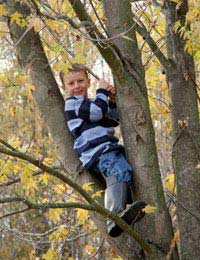Not Too Safe

Are your children too wrapped up in cotton wool to see the road ahead of them? Recent government calls for “common sense parenting” have prompted many parents to reassess the level of protection given to their children. There’s a fine line between safe and swaddled. How do we equip our children for the real world without threatening their independence?
In our efforts to keep children safe from dangers like kidnap, road accidents, poisoning and theft, it’s important that we don’t give them feelings of insecurity – or harness their natural independence.
What are the Real Risks?
The best way to protect your children is to identify the real risks – and act to prevent them.- Road accidents – today’s children are MUCH LESS likely to be run over by a car than they were 30 years ago. Even though there are more cars on the roads, child accidents have been reduced by a third since 1922.
- Abduction – your child is no more likely to be abducted than you were. Thirty years ago, the risks of abduction were the same as they are today; the media paints a frightening picture, but statistics tell us to stay calm. One in 882,300 children were abducted in 2002/03.
- Obesity – In 1971, 80% of children walked to school on their own, a valuable way to build independence and fitness. Today only 9% walk or cycle to school. Combined with increased computer usage, these factors have caused the child obesity rate to soar. Right now 16% of 6-year-olds are officially obese – and if the rate continues rising, that figure could go up to 50% by 2020.
- Internet risks – the government’s research showed that a horrifying 46% of children had given out personal information online. Even worse, only 5% of their parents were aware of it.
- Isolation risks – being unable to socialise and relate with other children can be a risk, hindering a child’s ability to deal with social issues and problem solving. Some organisations have warned parents to loosen the reins after a survey showed that 43% of parents don’t think children should be out unsupervised before the age of 14.
Secret Supervision
Of course it isn’t easy to give children freedom when you’re an anxious parent. But there are ways around it. Many parents operate a ‘surveillance’ programme to give their children the feeling of independence without losing touch. Neighbouring parents often allow children to play together on the street green or a local park, ensuring there is somebody nearby to keep a discreet eye on everyone.Parents who can’t allow their children to walk to school arrange trips to safe places such as playgrounds and beaches, where kids can let off some steam within adult supervision. Other parents arrange school-walking groups, accompanied by a different parent every day, to get their children active and sociable. Then there’s the mobile phone monitoring system, which you can use to check on your child’s whereabouts at all times. Whatever you do, make sure that your child protection policy includes some time for your children to be alone and discover things for themselves. We all need to fall out of a tree now and again...
Interested in Branding, a Website or Graphic Design?
You can receieve an elegantly built, fully customised website that generates enquiries for just £399, merchandise design from £59, or illustrations from just £35, all unique to you and your brand. Check us out here.








